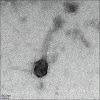Isolation of a Novel Phage and Targeting Biofilms of Drug-Resistant Oral Enterococci
- PMID: 32165796
- PMCID: PMC7045759
- DOI: 10.4103/jgid.jgid_110_19
Isolation of a Novel Phage and Targeting Biofilms of Drug-Resistant Oral Enterococci
Abstract
Introduction: Enterococci are now recognized as the second most cause of nosocomial infections worldwide. The emergence of multidrug-resistant strains in the organism has given rise to alternative strategies such as phage therapy. In this study, an Enterococcus faecalis infecting phage was isolated and its efficiency against biofilms formed by drug-resistant enterococci obtained from chronic periodontitis was evaluated.
Materials and methods: Bacteriophage against E. faecalis was isolated from sewage sample. The phage was propagated and identified using transmission electron microscope (TEM). In vitro biofilm formation was assessed.
Results: TEM microscopy showed that the phage belonged to Siphoviridae family. In the presence of the novel phage, the metabolic activity of enterococci biofilm was reduced at 48 h of contact. A difference of at least 5 log CFU/ml was seen in the live cells of the control biofilm, and the phage treated biofilm of enterococci isolates.
Conclusion: The study shows that the novel phage inhibits biofilm production in oral enterococci isolates from periodontitis patients but has a narrow host range. The role of bacteriophages as strong biotechnological and natural therapeutic agents for E. faecalis in chronic periodontitis can be considered.
Keywords: Bacteriophage; biofilm; enterococci; periodontitis.
Copyright: © 2020 Journal of Global Infectious Diseases.
Conflict of interest statement
There are no conflicts of interest.
Figures
Similar articles
-
Anti-biofilm Activity of a Lytic Phage Against Vancomycin-Resistant Enterococcus faecalis.Iran J Pathol. 2022 Summer;17(3):285-293. doi: 10.30699/IJP.2022.541855.2760. Epub 2022 Aug 12. Iran J Pathol. 2022. PMID: 36247507 Free PMC article.
-
Potential of phage EF-N13 as an alternative treatment strategy for mastitis infections caused by multidrug-resistant Enterococcus faecalis.J Dairy Sci. 2023 Dec;106(12):9174-9185. doi: 10.3168/jds.2022-22892. Epub 2023 Aug 23. J Dairy Sci. 2023. PMID: 37641240
-
Identification of Novel Bacteriophages with Therapeutic Potential That Target Enterococcus faecalis.Infect Immun. 2019 Oct 18;87(11):e00512-19. doi: 10.1128/IAI.00512-19. Print 2019 Nov. Infect Immun. 2019. PMID: 31451618 Free PMC article.
-
Phage therapy against Enterococcus faecalis in dental root canals.J Oral Microbiol. 2016 Sep 16;8:32157. doi: 10.3402/jom.v8.32157. eCollection 2016. J Oral Microbiol. 2016. PMID: 27640530 Free PMC article. Review.
-
Phage therapy: A renewed approach against oral diseases caused by Enterococcus faecalis infections.Microb Pathog. 2024 Apr;189:106574. doi: 10.1016/j.micpath.2024.106574. Epub 2024 Feb 13. Microb Pathog. 2024. PMID: 38354990 Review.
Cited by
-
Association of CRISPR-Cas System with the Antibiotic Resistance and Virulence Genes in Nosocomial Isolates of Enterococcus.Infect Drug Resist. 2022 Nov 30;15:6939-6949. doi: 10.2147/IDR.S388354. eCollection 2022. Infect Drug Resist. 2022. PMID: 36474907 Free PMC article.
-
Fully Characterized Effective Bacteriophages Specific against Antibiotic-Resistant Enterococcus faecalis, the Causative Agent of Dental Abscess.Medicina (Kaunas). 2024 Mar 19;60(3):501. doi: 10.3390/medicina60030501. Medicina (Kaunas). 2024. PMID: 38541227 Free PMC article.
-
Targeted Anti-Biofilm Therapy: Dissecting Targets in the Biofilm Life Cycle.Pharmaceuticals (Basel). 2022 Oct 12;15(10):1253. doi: 10.3390/ph15101253. Pharmaceuticals (Basel). 2022. PMID: 36297365 Free PMC article. Review.
-
Characterization of the Bacteriophage vB_EfaS-271 Infecting Enterococcus faecalis.Int J Mol Sci. 2020 Sep 1;21(17):6345. doi: 10.3390/ijms21176345. Int J Mol Sci. 2020. PMID: 32882938 Free PMC article.
-
SVep1, a temperate phage of human oral commensal Streptococcus vestibularis.Front Microbiol. 2023 Sep 12;14:1256669. doi: 10.3389/fmicb.2023.1256669. eCollection 2023. Front Microbiol. 2023. PMID: 37779698 Free PMC article.
References
-
- Marra A, Dib-Hajj F, Lamb L, Kaczmarek F, Shang W, Beckius G, et al. Enterococcal virulence determinants may be involved in resistance to clinical therapy. Diagn Microbiol Infect Dis. 2007;58:59–65. - PubMed
-
- Sievert DM, Ricks P, Edwards JR, Schneider A, Patel J, Srinivasan A, et al. Antimicrobial-resistant pathogens associated with healthcare-associated infections: Summary of data reported to the National Healthcare Safety Network at the Centers for Disease Control and Prevention, 2009-2010. Infect Control Hosp Epidemiol. 2013;34:1–4. - PubMed
-
- Jakubovics NS, Burgess JG. Extracellular DNA in oral microbial biofilms. Microbes Infect. 2015;17:531–7. - PubMed
-
- Schaudinn C, Gorur A, Keller D, Sedghizadeh PP, Costerton JW. Periodontitis: An archetypical biofilm disease. J Am Dent Assoc. 2009;140:978–86. - PubMed
-
- Mah TF, Pitts B, Pellock B, Walker GC, Stewart PS, O'Toole GA. A genetic basis for Pseudomonas aeruginosa biofilm antibiotic resistance. Nature. 2003;426:306–10. - PubMed




